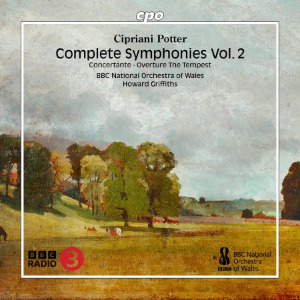
Cipriani Potter (1792-1871)
Complete Symphonies Volume 2
Symphony in C minor (1826/1847)
Concertante for Piano, Violin, Violoncello, Double Bass and Orchestra in D minor (c.1828)
Symphony in B-flat major (1821)
Overture to The Tempest (1837)
Mishka Rushdie Momen (piano), Jonian Ilias Kadesha (violin), Tim Posner (violoncello), Philip Nelson (double bass)
BBC National Orchestra of Wales /Howard Griffiths
rec. 2022/23, Hoddinott Hall, Cardiff, UK
cpo 555 500-2 [77]
I remember well the considerable interest, excitement even, when a CD of two Symphonies by Cipriani Potter came out in 1989 on Unicorn-Kanchana (DKP9091); Hilary Davan Wetton conducted the erstwhile Milton Keynes chamber orchestra. Not only was Potter really unknown but he had been briefly a pupil of Beethoven (who, because of his deafness perhaps, seemed to have called him ‘Porter’ or ‘Botter’). In any case, the great man held Potter in high regard, and suggested advanced studies with his close friend Emanuel Förster.
Now, as worthy as that orchestra was, it is great that a BBC ensemble has taken this music seriously. I have missed Volume 1 on cpo, with the First Symphony and other works (555274-2 – review).
Potter’s admiration for Beethoven (indeed, he apparently played some of the Master’s sonatas in public) may explain why what appears to be his Sixth Symphony is in C minor– as is Beethoven’s Fifth. But the numbering is confusing. Perhaps the number refers to the fact that twenty years after the original composition this work was shortened and the middle movements swapped. But it is a fine work, worthy of study. The first movement is in sonata form with interesting writing for the woodwind, especially in the E flat major second subject. The second movement, Andantino con moto, is glowing and elegant. The booklet writer describes the main idea of the Scherzo third movement as a ‘grim minuet’, a little harsh; perhaps one should say ‘serious’. The finale has a Mendelssohnian touch of lightness about it, and the work ends emphatically.
The Symphony in B flat major (in three movements – Allegro, Andante and Vivace ) has no number but the booklet lists it as the second extant symphony; little survives of a later revision. I find it less impressive than the C minor symphony. It lacks material arresting enough to hold one’s attention. Even so, with each movement in sonata form if not always too strictly adhered to, one can find one’s way through the themes and developments. In fact, the outstandingly detailed booklet notes, typical of cpo, help a lot; there even are timings to illustrate crucial formal points. The orchestration is not as original as in the C minor work but there some felicitous woodwind passages, and the middle movement is worthy of Schumann.
We can probably assume that the Concertante for Piano, Violin, Cello, Double Bass and Orchestra is a unique work. Not only it has somewhat bizarre scoring but it is based on the old melody La folia, or – as Potter titles it, quite rightly – Les Folies d’Espagna. It was first heard in 1829, with the great Domenico Dragonetti as the double bassist. There are five variations (interlinked by orchestral passages) which tend to begin or be led by the soloists. Their parts are often virtuosic, but only in the final moments of the almost fourteen minutes do they merge more with the orchestra. It is all quite fascinating, and utterly enjoyable.
The Overtureto The Tempest of 1837, a dramatic work, is more like an orchestral fantasy, as Bert Hagels’s booklet essay says. It is somewhat unusual for its period. It is hard to understand how the music might fit the plot of Shakespeare’s complex play but it is sometimes suitably tempestuous and sometimes almost peaceful and decidedly English. It eschews standard sonata form and creates its own world, something approaching the realm of Liszt perhaps. I wondered, in the end, if Potter had recalled Prospero’s words to Ferdinand in Act IV: ‘All thy vexations / Were but my trials of thy love and thou / Hast strangely stood the test.’
The recording is very pleasingly spaced. This enables one, for example, to grasp clearly passages of imitation with a wide depth of field. I look forward to the possibility of Volume 3 with, I should imagine, an alternative version of the Eighth or Tenth Symphony, those on the Unicorn Kanchana disc. Worth investigating.
Gary Higginson
Buying this recording via a link below generates revenue for MWI, which helps the site remain free




















